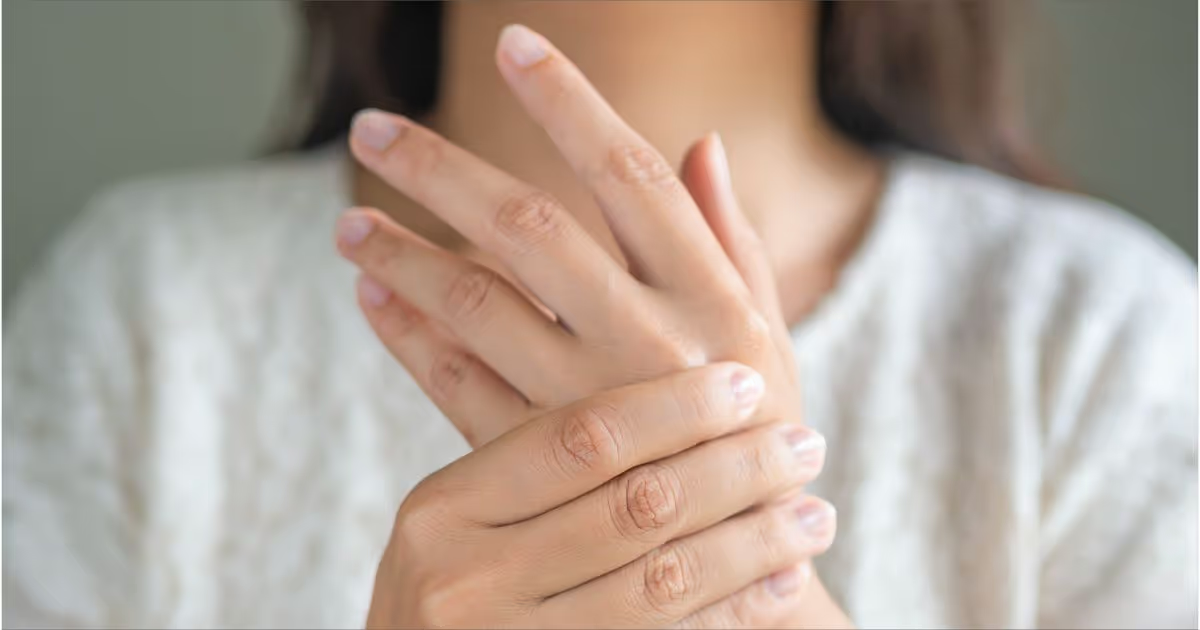Rheumatoid arthritis (RA)
Rheumatoid arthritis (RA) is a type of arthritis due to chronic joint inflammation that can occur in different body joints. Symptoms gradually develop and persist over time. Many joints of the hands, wrists, and knees are often simultaneously affected. Long-term joint tissue damage can lead to chronic pain, difficulty balancing, and deformity. Each person develops rheumatoid arthritis at different times and experience differing symptoms, severity, and complications.
Risk factors
The cause of rheumatoid arthritis is not yet clear, but two types of factors increase the risk of developing the condition:
Susceptibility factors
- Age: Anybody can have rheumatoid arthritis, but the risk increases with age.
- Gender: Women have a 3-fold higher risk of developing rheumatoid arthritis.
- Genetics: If you have a family member with rheumatoid arthritis, you are at a higher risk of developing it.
Initiating factors
People with susceptibility factors may not develop rheumatoid arthritis until exposed to initiating factors, such as:
- Smoking
- Stress
- Infections, particularly gum infections
Symptoms
At the onset, you may develop symptoms such as a low-grade fever, muscle pain, fatigue, weight loss, and numbness and tingling in the hands weeks or months before having joint pain or stiffness.
The pain usually starts from small joints in both hands and feet, such as the base of fingers or toes, and progresses to larger joints in the arms or legs. Less frequent, it may begin in a single large joint such as a knee or shoulder joint. Usually, you will have symmetrical arthritis when the same joints on both sides are affected. Pain can be more intense on one side than the other. Common symptoms are pain, stiffness, tenderness, increased warmth, and swelling. The joint stiffness is more in the morning, which may worsen after not moving for a while and can last more than 1 hour.
At the early stages of the disease, these joints are often affected.
- Hands: Rheumatoid arthritis usually causes tenderness in the hand joints and loss of hand grip strength. Finger and hand deformities such as boutonniere can develop with persistent joint inflammation.
- Wrist: You have difficulty bending the wrist backward.
- Elbow: You feel numbness and tingling in the fingers from the swollen joint compressing the nerves.
- Foot: Tenderness starts in the joints at the base of the toes, so you will begin to put more weight on the heels.
- Ankle: Nerves compressed by tissue inflammation will make you feel numb in the foot.
- Knee: You have difficulty bending the knee. The ligaments supporting the knee become loose, and the knee joint bones may rub against each other, leading to Baker's cyst.
At later stages, the disease may progress to the following joints of your body.
- Neck: It is challenging to turn and bend your neck due to neck inflammation. You have headaches and a stiff neck.
- Shoulder: You have shoulder motion limitation.
- Hips: The inflammation of the hip makes it more difficult for you to walk.
- Cricoarytenoid joint: A few people may develop inflammation in the cricoarytenoid joint near the windpipe, causing difficulty breathing and hoarseness.
Besides joint problems, rheumatoid arthritis can cause other complications due to inflammation and/or side effects from the medications.
- Bone loss
- Muscle weakness
- Skin problems such as rheumatoid nodules particularly on the underside of the forearm, on the elbow, the back of the head, the base of the spine, the Achilles tendon, and the tendons of the hand.
- Eye inflammation and vision problems
- Shortness of breath and dry cough due to lung inflammation
- Pericarditis
- Vasculitis
- Sjogren’s syndrome
- Cardiovascular diseases such as stroke and heart attack
- Cancer risks such as lymphomas or skin cancer
Diagnosis
The diagnosis of rheumatoid arthritis requires multiple investigations to pinpoint the disease.
- Medical history
- Physical examination
- Blood tests
- Imaging tests
- Clinical observation over time
You are likely to develop rheumatoid arthritis if you have the following findings:
- Three or more joint inflammations that last for six weeks or more
- High inflammatory markers, i.e., erythrocyte sedimentation rate (ESR) and C-reactive protein (CRP)
- Rheumatoid factor (RF) and anti-citrullinated peptide/protein antibodies (ACPAs)




